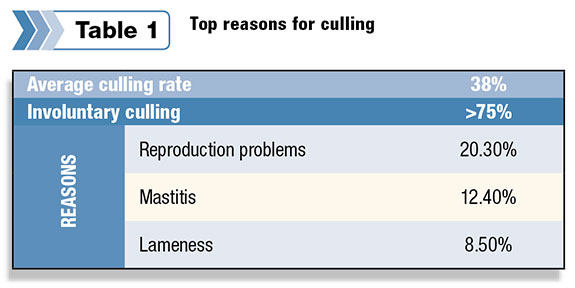The strong selection for milk production has led to the increase of metabolic diseases around calving, which leads to reduced immunity, impaired reproduction and multiple health problems.

This translates into a very high culling rate in most herds. In fact, reproduction, mastitis and lameness are the major causes of involuntary culling (See Table 1).
This occurrence is very costly for producers.
Although the overall management of cows is critical, this article will concentrate on nutrition and its essential role, as feed accounts for more than 50 percent of production costs.
The essential role of micronutrients
For decades, we have concentrated on macronutrition, energy, protein and macrominerals.
We never anticipated that trace elements such as selenium and copper, fat-soluble vitamins like A, D and E, and water-soluble vitamins such as choline, folic acid, riboflavin and others could have such an impact on the overall metabolism of carbohydrates, fats and protein.
It has since been discovered that B vitamins specifically have an impact on immune function during transition and are involved in the expression of certain genes necessary for the regulation of metabolic processes and reproduction (nutrigenomics).
Recent research on B vitamins
Important pieces of research have created new perspective for nutrition during the transition and lactation periods. It has been proven that B vitamins are very much degraded in the rumen, which justifies their protection when added in feed.
Choline and folic acid play a very significant role in the reduction of liver fat infiltration, caused by tissue mobilization during the transition period.
Folic acid and B12 improve energy balance by reducing the cow’s mobilization of fat tissues. Oxidative stress has a negative impact on the immune system and reproductive ability of the cow.
Riboflavin has an important enzyme cofactor role, which helps reduce oxidative stress. Protected B vitamins, including folic acid, riboflavin and choline, fed during the transition period reduced BHB levels in blood, leading to less metabolic disorders and improved reproduction.
A blend of protected B vitamins containing folic acid, biotin, pantothenic acid, pyridoxine and vitamin B12 showed beneficial effects on reproduction and reduced the involuntary culling rate.
Nutrigenomics and B vitamins
Recent research on nutrigenomics have shown that folic acid and vitamin B12 affected the expression of specific genes and could regulate both follicular development and ovulation processes in dairy cows.
Producers face real challenges when dealing with metabolic diseases around calving and their resulting problems like mastitis, metritis and decreased reproduction, to name a few.
Micronutrients, more specifically B vitamins, are now known to play a critical role for some essential metabolisms. This better understanding of their specific mode of action on different cells (ovary, liver, mammary gland) and metabolisms now permits an opportunity for new nutritional solutions to solve problematic situations that are often assumed and accepted as normal. PD
Helene Leclerc provides technical support and R & D for Jefo.
References omitted due to space but are available upon request. Click here to email an editor.

- Angela Lipka
- Canadian Product Manager
- Jefo









